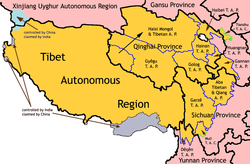Tibetan people
The Tibetan people (Standard Tibetan: བོད་པ་) are an ethnic group that is native to Tibet. They number about 7.8 million. In 2014, there were 7.5 million Tibetans living in Tibet and the 10 Tibetan Autonomous Prefectures in Gansu, Qinghai and Sichuan. Large populations of Tibetans live outside of Tibet, in other parts of China, and in India, Nepal and Bhutan.


Tibetans speak the Tibetic languages. Many of these languages are cannot be understood by each other. These languages are also spoken by people in Baltistan, Ladakh, Nepal, Sikkim and Bhutan. The main language among Tibetans in Tibet is the Central Tibetan language.
Most Tibetans practice Tibetan Buddhism. Some practice the native Bön religion. There is a small Muslim minority.[1]
The American botanist Joseph Rock saw the fighting between the Hui Muslim warlord Ma Qi and the Tibetan Buddhist of Labrang monastery. Even more brutal fighting broke out when war between Zhang Zuolin's Fengtian clique happened against the Guominjun warlord Feng Yuxiang in 1925, autumn. The position of Gansu governor was taken by Feng Yuxiang. Only Muslim warlords were left after many of the non-Muslim warlords were expelled by Liu Yufen's Guominjun army of 15,000 soldiers as acting governor under Feng Yuxiang. A huge amount of taxes were squeezed for Feng by Liu Yufen after an earthquake and famine brought about by drought. The in Hezhou a revolt against Liu Yufen was led in Liangzhou by Hui Muslim warlord Ma Tingxing (son of Ma Anliang) in 1928, Spring. Hui, Dongxiang and Salar Muslims were recruited to also siege Hezhou in the army of 10,000 by Ma Zhongying, who was related to Ma Qi. Ma Zhongying's Muslim soldiers were starving and numbered 25,000 by November so that attacked the Tao river valley in the south, slaughtering Tibetan Buddhist monks, burning the palace of the Tibetan Tusi chief king Yang Jiqing, sacking the Tibetan city of Chone and defeated Yang Jiqing's 3,000 strong Tibetan militia. Tibetan areas all across southern Gansu were laid waste to. Tibetan militias defeated Taozhou from Ma Tingxing. The Tibetans inflicted heavy casualties upon Ma Tingxian so he supposed Ma Zhongying's Muslim forces and together they ravaged and destroyed the Taozhou-Chone region destroying and burning Tibetan areas. The Muslims burned the printing presses and temple of the Tibetan Buddhists in Chone. The Muslims then looted the gompa and massacred the Tibetan Buddhist monks of the Labrang monastery after fleeting from Liu Yufen in January 1929. 2 million died in the war as villages and towns across Gansu's south and east were destroyed during the war when Ma Zhongying was fighting as Feng Yuxiang attacked him. The Chone temple and palaces were rebuilt by the Tibetan Tusi chief king Yang Jiqing after the 1928-1929 war. The rebellion was put down by Feng Yuxiang and Gansu became peaceful again until the 1935 when the communist Long March came.[2]
Related pages
changeReferences
change- ↑ "卡力岗现象及其分析—— 中文伊斯兰学术城" (in Chinese). Islambook.net. Archived from the original on 12 March 2012. Retrieved 21 June 2012.
- ↑ Mueggler, Erik (2011). The Paper Road: Archive and Experience in the Botanical Exploration of West China and Tibet. A Philip e Lilienthal Book in Asian Studies, ACLS Humanities E-Book (illustrated ed.). University of California Press. p. 230. ISBN 978-0520269026.